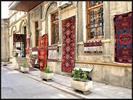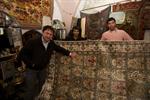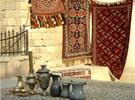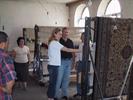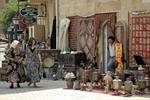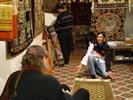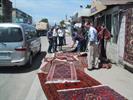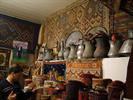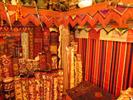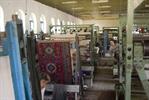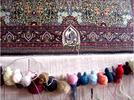Carpet making is a very old and highly developed craft. Archaeological finds bear evidence that it was already in existence back in the 9th century B.C. Written sources of later periods, for instance, writings by antique Greek, Roman and Arab authors (Herodotus, Xenophon, Al-Mugaddasi), also indicate that carpet making is indeed a very old craft. In Azerbaijan, it has developed over centuries to reach the summit of perfection. Azerbaijan craftsmen have produced magnificent specimens - from simple pileless carpets to the exquisite khalcha variety.
It is accepted to divide Azerbaijan carpets into four types:
1. Guba-Shirvan (with manufacturing centres in Guba, Shirvan and Baku);
2. Ganja-Gazakh (with manufacturing centres in Ganja and Gazakh);
3. Garabakh (with manufacturing centres in Garabakh, Shusha and Jabrail);
4. Tebriz (with manufacturing centres in Tebriz and Ardebil).
They are mainly distinguished by the following features: ornament, manufacturing technique and the kind of article in question. Azerbaijan carpets are noted for a vast variety of ornamental compositions which now exceed 600. Some very rich and intricate designs were popular within the boundaries of a particular village or town or ethnic group and were handed down from generation to generation as a valuable heritage. Some carpet designs therefore bear the names of the localities where they originated, for instance, Pirebedil, Chichi, Afurdja, Salakhly and Shikhly, or of the ethnic groups that invented them, such as Sor-sor, Djek, Gryz, Gasym ushegy, Talysh and Gara goyunlu. The distinctive feature of Azerbaijan carpets is that their decorative scheme comprises phyto-morphous, zoomorphous, anthropomorphous (this despite the taboo to depict human images) and geometrical elements, highly conventionalized when conveyed onto a carpet. In earlier periods, some designs had a definite clear meaning which was lost with the passage of time.
The greater part of carpet decorative motifs is common to other Azerbaijan crafts too. The similarity of ornament in metal, fabrics, ceramics, etc. is traceable among the specimens of the ethnographic fund.
The central motif of the Khilabuta carpet, the "buta" ornament, is found in many variations of handicraft articles. For the most part, decorative motifs are borrowed from the natural environment or suggested by everyday life. It has been established, for instance, that honeycombs, which symbolize wealth and prosperity, form the basis of the design of Shilyan piled carpets.
Azerbaijan carpets are manufactured in various techniques. Basically they are divided into piled and pileless.
Pileless ones include palas, kilim, sumakh, zili, shadde and verni. Palas and kilim are simply woven, while sumakh, zili, shadde and verni have an intricate weave.
Piled carpets require especially sophisticated techniques. Here one should master an entirely different technique, with a pile knot applied to every two warp threads, making it possible to bring out a host of designs of any shape or size.
This catalogue acquaints the reader with all types of carpets of the ethnographic fund, giving a graphic idea of their technological and artistic merits.
A distinguishing feature of the Azerbaijan piled carpets is a very close arrangement of knots. The density of a carpet is determined by the number of knots per square decimeter. It varies with localities from 1600 (40 X 40) to 4900 (70 X 70) pile knots.
Azerbaijan carpet makers use yarn dyes of basic seven colours of varying shades. Over centuries they have developed compositions of dyes obtained from local plants. Unlike chemical dyestuffs, natural colorants do not erode the structure of wool fibers, but lend them sheen and succulence. Having mastered manufacturing techniques to perfection, Azerbaijan carpet makers began producing sets (dast) consisting of a large central carpet, two side rugs and one head piece, all united in a single composition; prayer rugs (namazlyg); pictorial and other types of carpets.
Carpets were to meet both aesthetic and utilitarian requirements. As an object of household use, which was its main purpose, the carpet served to keep the house warm. Carpet bags and coverlets, of varying types were widespread. These included pileless mafrash, khurdjun and kheiba (travelling bags); chuval (sacks for holding loose products); chul (all kinds of coverlets); yakhar ustu (saddle cover) and other objects.
The best specimens of Azerbaijan carpet making art are displayed at major museums of the Union of Independent Countries, Europe and America, which testifies to the high level of the old but never ageing culture of the Azerbaijan people.
If you're planning a trip to Azerbaijan: Check The latest information of visa regime in Azerbaijan. Please do not hesitate to contact us for consultation.



